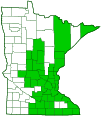small-spike false nettle
(Boehmeria cylindrica)
Conservation • Wetland • Description • Habitat • Ecology • Use • Distribution • Taxonomy
Description |
||
Small-spike false nettle is a 16″ to 40″ tall, erect, perennial forb that rises from a rhizome. The stems are erect, stiff, and usually unbranched. They may be smooth and almost hairless or densely covered with soft hairs. They do not have stinging hairs. The leaves are opposite or nearly opposite. Rarely, some leaves are alternate. They are on long, slender, hairy or almost hairless leaf stalks (petioles). At the base of each petiole is a pair of lance-shaped to awl-shaped, leaf-like appendages (stipules). The stipules are not fused to the petiole. The leaf blades are elliptic, lance-shaped, or broadly egg-shaped, 2″ to 7″ long, and ¾″ to 4″ wide. They are longer than the petiole. They taper to a point at the tip with concave sides along the tip. They are rounded or heart-shaped at the base. There is a prominent midvein and two prominent lateral veins. The upper surface is dull green. It may be smooth and almost hairless or rough to the touch due to a covering of short, stiff hairs. The lower surface paler green. It may be smooth and almost hairless or densely covered with soft, long or short hairs. The hairs on the lower surface are not white and woolly. The leaf margins are coarsely toothed with sharp or rounded teeth. The leaves and leaf stalks do not have stinging hairs. Male and female flowers are usually found on the same plant (monoecious). Rarely a plant will have only male or only female flowers (dioecious). The inflorescence is an unbranched spike rising at an angle from the upper leaf axils. The spike is straight and ½″ to 3″ long. It is usually longer than the petiole of the subtending leaf, and is usually terminated by two or more leaves. The flowers are borne singly or in dense, head-like, widely-spaced clusters along the central axis of the spike. The clusters are composed of 1 to a few male flowers and several female flowers. On the rare dioecious plant the spike will be all male and interrupted or all female and continuous. Male flowers have 4 sepals, no petals, and 4 stamens. The sepals are separate, not fused together. Female flowers have 4 sepals, no petals, and 1 style. The sepals are fused into an egg-shaped, flattened tube (calyx) with 2 to 4 minute teeth at the tip. The ovary is above the point of attachment of the calyx. Male and female flowers have no fragrance. The fruit is a flattened, egg-shaped achene, 1 ⁄32″ to 1 ⁄16″ long and wide. As the achene is formed the calyx continues to enlarge, ultimately completely enclosing the achene, and the style hardens, forming a short, prolonged tip (beak). The achene has two narrow, thin, flat, membranous appendages (wings) which aid in dispersal. |
||
Height |
||
16″ to 40″ |
||
Flower Color |
||
Green |
||
Similar Species |
||
Canadian clearweed (Pilea pumila) is a shorter plant, no more than 20″ tall. It has hairless stems and leaves. The upper leaf surface is shiny. The leaf margins have fewer, larger, more rounded teeth. The flower spike is usually shorter than the petiole of the subtending leaf, and is not terminated by leaves. The persistent calyx loosely subtends, does not completely enclose, the achene. Canadian woodnettle (Laportea canadensis) leaves are alternate and broader. The stem and leaves have obvious stinging hairs. Stinging nettle (Urtica dioica ssp. gracilis) leaves are narrower, and drooping. The stem and leaves have obvious stinging hairs. |
||
Habitat |
||
Moist or wet. Floodplain woodlands, deciduous woods, swamps, bogs, marshes, wet meadows, ditches, riversides. Light shade. |
||
Ecology |
||
Flowering |
||
August to September |
||
Pests and Diseases |
||
|
||
Use |
||
|
||
Distribution |
||||
|
Sources |
|||
| 6/17/2023 | ||||
Nativity |
||||
Native |
||||
Occurrence |
||||
|
||||
Taxonomy |
|||
| Kingdom | Plantae (Plants) | ||
| Division | Tracheophyta (Vascular Plants) | ||
| Subdivision | Spermatophytina (Seed Plants) | ||
| Class | Magnoliopsida (Dicots) | ||
Order |
Rosales (Roses, Elms, Figs, and Allies) | ||
Family |
Urticaceae (nettle) | ||
Genus |
Boehmeria (false nettles and allies) | ||
Subordinate Taxa |
|||
|
|||
Synonyms |
|||
Boehmeria austrina Boehmeria cylindrica var. drummondiana Boehmeria cylindrica var. scabra Boehmeria decurrens Boehmeria drummondiana Boehmeria scabra Urtica cylindrica |
|||
Common Names |
|||
smallspike false nettle small-spike false nettle |
|||
Glossary
Achene
A dry, one-chambered, single-seeded seed capsule, formed from a single carpel, with the seed attached to the membranous outer layer (wall) only by the seed stalk; the wall, formed entirely from the wall of the superior ovary, does not split open at maturity, but relies on decay or predation to release the contents.
Axil
The upper angle where the leaf stalk meets the stem.
Beak
A comparatively short and stout, narrow or prolonged tip on a thickened organ, as on some fruits and seeds.
Calyx
The group of outer floral leaves (sepals) below the petals, occasionally forming a tube.
Dioecious
Having imperfect flowers: the staminate flowers (male) and pistillate flowers (female) are borne on separate plants.
Monoecious
A characteristic of a plant that has separate male and female reproductive structures on the same individual plant.In flowering plants, staminate (male) flowers and pistillate (female) flowers. In conifers, pollen cones (male cones) and seed cones (female cones).
Petiole
On plants: The stalk of a leaf blade or a compound leaf that attaches it to the stem. On ants and wasps: The constricted first one or two segments of the rear part of the body.
Rhizome
A horizontal, usually underground stem. It serves as a reproductive structure, producing roots below and shoots above at the nodes.
Sepal
An outer floral leaf, usually green but sometimes colored, at the base of a flower.
Stipule
A small, leaf-like, scale-like, glandular, or rarely spiny appendage found at the base of a leaf stalk, usually occurring in pairs and usually dropping soon.
Wing
A thin, flat, membranous, usually transparent appendage on the margin of a structure.
Visitor Photos |
|||||
Share your photo of this plant. |
|||||
| This button not working for you? Simply email us at info@MinnesotaSeasons.com. Attach one or more photos and, if you like, a caption. |
|||||
|
|||||
MinnesotaSeasons.com Photos |
|||||
Plant |
|||||
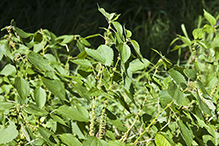 |
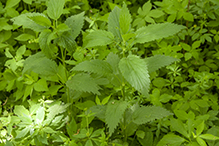 |
||||
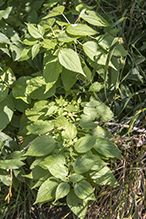 |
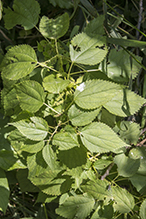 |
||||
Inflorescence |
|||||
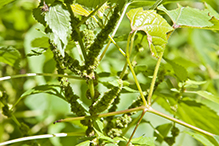 |
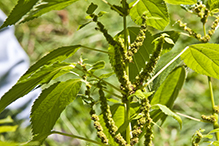 |
||||
Leaf |
|||||
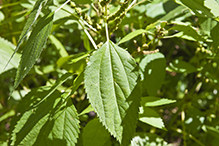 |
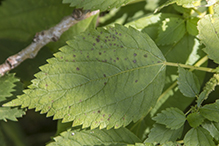 |
||||

Slideshows |
||

Visitor Videos |
|||
Share your video of this plant. |
|||
| This button not working for you? Simply email us at info@MinnesotaSeasons.com. Attach a video, a YouTube link, or a cloud storage link. |
|||
Other Videos |
|||

Visitor Sightings |
|||||
Report a sighting of this plant. |
|||||
| This button not working for you? Simply email us at info@MinnesotaSeasons.com. Be sure to include a location. |
|||||
|
|||||
MinnesotaSeasons.com Sightings |
|||||

|
Created: Last Updated: © MinnesotaSeasons.com. All rights reserved. |
